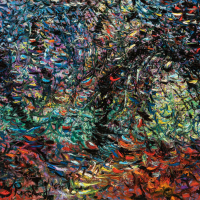36. JOHN PERCEVAL

In January 1963, John and Mary Perceval sold their family home in Melbournes eastern suburbs and moved to London. Their arrival coincided with what curator Bryan Robertson described as the most auspicious moment in [the twentieth] century for the reception of Australian art by the English.1 In the decade between 1955 and 1965, London attracted nearly all the leading exponents of Australian modernism: Arthur Boyd (1920-1999), Brett Whiteley (1939-1992), Michael Johnson (born 1938), Sidney Nolan (1917-1992), Charles Blackman (1928-2018), Fred Williams (1927-1982) and John Perceval. As Blackman recalled, this boisterous coterie of expat Australian painters represented Quite a sum of forces of nature, of painting, from this country. And we all saw each other. Being there at that time, it was unique in history, I think.2
The Percevals took up residence in the suburb of Highgate, on the edge of Hampstead Heath. The Heath, a rambling expanse of parkland on Londons northern perimeter, held an evocative place within the British landscape tradition as a subject favoured by John Constable (1776-1837). Arthur Streeton (1867-1943) had also painted in the area while living in London at the turn of the twentieth century, as seen in his View of Hampstead Heath from Jack Straws Castle c1901-08 in the National Gallery of Australia.
Percevals approach to this traditional subject was blatantly unorthodox. His Hampstead paintings of 1963-64 sit somewhat uneasily within the landscape genre, since they focus not on any perspective of the land itself but on its raw vegetation. Art historian Margaret Plant records a description of Perceval on location at Hampstead as:
an odd figure swathed in voluminous clothes as if setting off for the Arctic, finishing his picture in three or four hours despite the weather, sitting up in a sleeping bag with whisky by his side.3
Tangled Arch in the Deserted Garden, Highgate is a kaleidoscopic flurry of movement and colour born from Percevals immersion within the landscape. The painting eschews all sense of perspective as the subject is emphatically brought to the surface, with whipped-up impasto.4 The artists vision of the undergrowth is unruly and tactile, with little distinction between leaves, trunks and branches.5 Percevals painting is driven by visual impulse and sensation:
at all times my work is primarily a response to the subject, to light and trees, air, people etc. Whatever success it may achieve is due to a desire to equate the vitality, the pulse of life in nature and the world around us.6
The present work was first shown alongside Percevals other Hampstead pictures at the Zwemmer Gallery in March 1964. The exhibition was well received by the British press, with one critic remarking that the canvases were full of movement and the sensuous splendour of the matire.7 Like all great modern art, Tangled Arch in the Deserted Garden, Highgate still retains freshness and vitality, some sixty years after its creation.
Footnotes:
1. Robertson, B., The London Years, in Pearce, B., Brett Whiteley: Art & Life, Thames & Hudson in association with the Art Gallery of New South Wales, Sydney, 1995, p.8
2. Shapcott, T., The Art of Charles Blackman, Andr Deutsch Limited, London, 1989, p.4
3. Plant, M., John Perceval, Lansdowne Press, Melbourne, 1971, p.93
4. Ibid.
5. Ibid.
6. John Perceval, quoted in Plant, M., John Perceval, p.76
7. G.S. Whittet, quoted in Plant, M., John Perceval, p.94
Catherine Baxendale, B Phil (Hons), MA (Art Curatorship)